5000 Years Gangeshwar Mahadev Temple
The Gangeshwar Mahadev Temple, also known as Gangeshwar Temple, is a Hindu temple dedicated to Lord Shiva (Mahadeva) located at the seashore of Fudam village just 3 km away from Diu in the union territory of Daman and Diu, India. The view of the temple is unique set on the Arabian Sea. It is basically a cave temple situated in the midst of the rocks on the seashore.
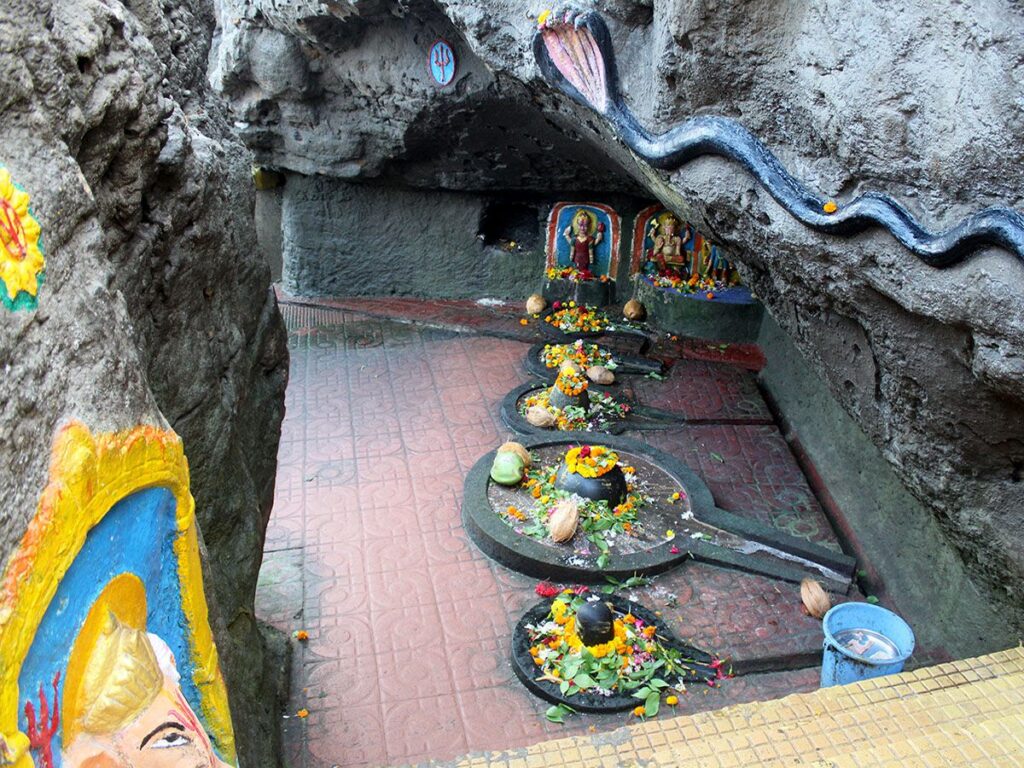
Contents
- 1 Gangeshwar Mahadev Temple History:
- 2 Legend of Gangeshwar Mahadev Temple:
- 3 Myths of Gangeshwar Mahadev Temple:
- 4 Significance of Gangeshwar Mahadev Temple:
- 5 Gangeshwar Mahadev Temple Timing and Rituals:
- 6 Specialty of Gangeshwar Mahadev Temple:
- 7 Places to visit near Gangeshwar Mahadev Temple:
- 8 FAQ:
- 9 How to reach Gangeshwar Mahadev Temple:
- 10 Google Maps:
Gangeshwar Mahadev Temple History:
Ancient Origins:
- 5000 Years Old: Legend and some archaeological findings suggest the temple’s existence for over 5000 years, making it a truly ancient shrine.
- Mahabarata Connection: A popular legend attributes the temple’s creation to the Pandava brothers, heroes of the epic Mahabharata. During their exile, they are said to have carved five Shivalingas in the cave for daily worship.
Lingas and Rituals:
- Five Shivalingas: The temple houses five Shivalingas, each carved into the natural rock face. Their sizes are believed to represent the heights of the Pandava brothers.
- Unique Offering: The temple’s unique feature is the ocean waves washing over the Shivalingas every few seconds. Devotees offer prayers and touch the linga when the waves recede, creating a mesmerizing and spiritual experience.
Temple and Deities:
- Cave Structure: The temple itself is a natural cave, adding to its mystical charm.
- Other Deities: Besides Lord Shiva, the temple also houses statues of Lord Ganesha, Lord Vishnu, and Goddess Lakshmi.
- No Priests: Interestingly, the temple has no designated priests, and offerings are washed away by the waves, symbolizing the transient nature of material things.
Read More>> Kalaram Temple Nashik
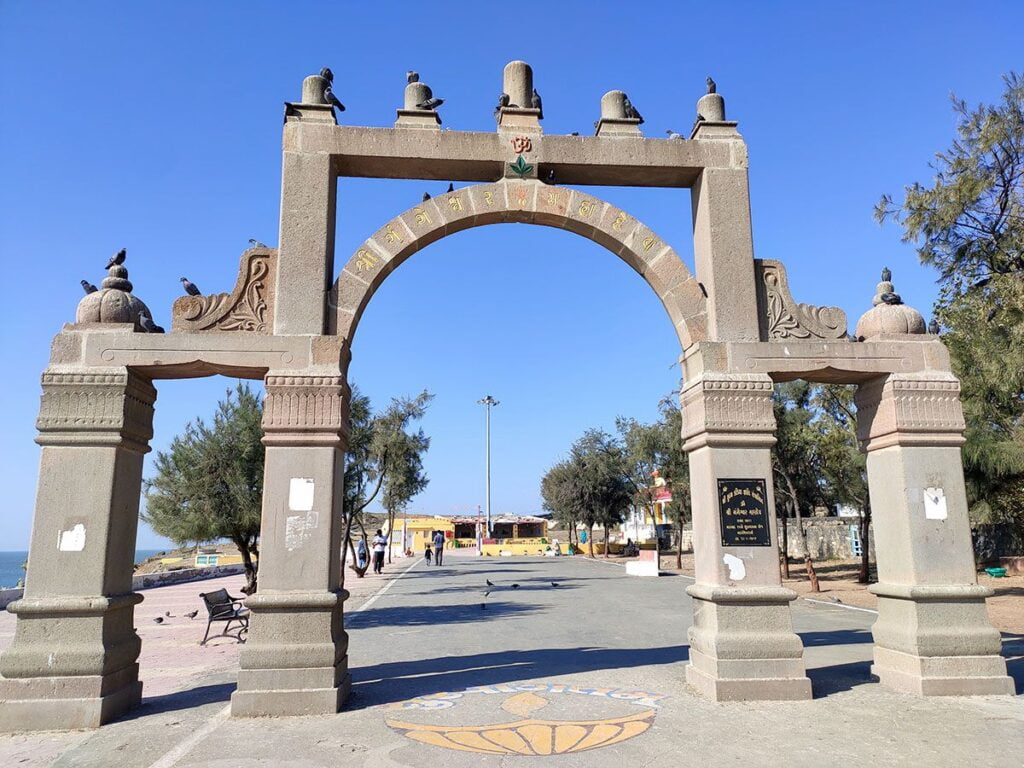
Legend of Gangeshwar Mahadev Temple:
The Pandava Connection: According to this legend, the five Shiva Lingas at the heart of the temple were installed by the Pandavas, the righteous heroes of the epic Mahabharata. During their 12-year exile, the Pandavas sought refuge in Diu. Before every meal, they wished to perform Shiva puja, but with no readily available Shivling, they carved five out of the rocks themselves, invoking the five elements – earth, water, fire, air, and ether. These five lingas, each unique in size and shape, remain a significant attraction, believed to be imbued with the Pandavas’ devotion.
The Ganga Link: Another legend attributes the temple’s name, Gangeshwar, to the mighty river Ganga. It is said that when the celestial river threatened to flood the earth with her powerful descent, Lord Shiva intervened. He caught her in his matted hair, calming her flow and saving the world. This act earned him the title “Gangadhara” (Bearer of the Ganges), and the temple’s name is seen as a homage to this divine association.
Read More>> Kundrathur Murugan Temple Chennai
Myths of Gangeshwar Mahadev Temple:
1. The Touch of the Pandavas:
Legend has it that during their 13-year exile, the Pandavas, heroes of the Hindu epic Mahabharata, sought refuge in Diu. To atone for their sins and seek Lord Shiva’s blessings, they carved five Shivalingas on the face of the rock, using the holy waters of the Ganges that flowed from Shiva’s matted hair. These five lingas, of varying sizes, stand as a silent testament to their penance and devotion.
2. The Song of the Sea:
The rhythmic ebb and flow of the Arabian Sea plays a mesmerizing role in the temple’s mystique. During high tide, the waves embrace the Shivalingas, offering a sacred abhisheka, a holy bath. As the tide recedes, devotees rush to touch the lingas, believing it to be a divine blessing. The sight of the ocean worshipping Shiva, its waves a celestial melody, is a sight to behold.
3. The Whispers of Ravana:
Another legend attributes the temple’s origin to the fearsome demon king Ravana. Fearing Shiva’s wrath, Ravana tried to uproot Mount Kailash, Shiva’s abode. However, a piece of the mountain fell into the sea, landing on the shores of Diu. This fragment, imbued with Shiva’s presence, became the foundation of the Gangeshwar Mahadev Temple.
4. The Ganges in the Seashore:
The name “Gangeshwar” itself holds a mythical significance. “Ganga” refers to the holy river Ganges, and “Iswar” means Lord. It is believed that a drop of the Ganges, carried by Shiva in his hair, fell onto the lingas, sanctifying the temple and earning it its name.
Read More>> Nambunayaki Amman Temple Rameswaram
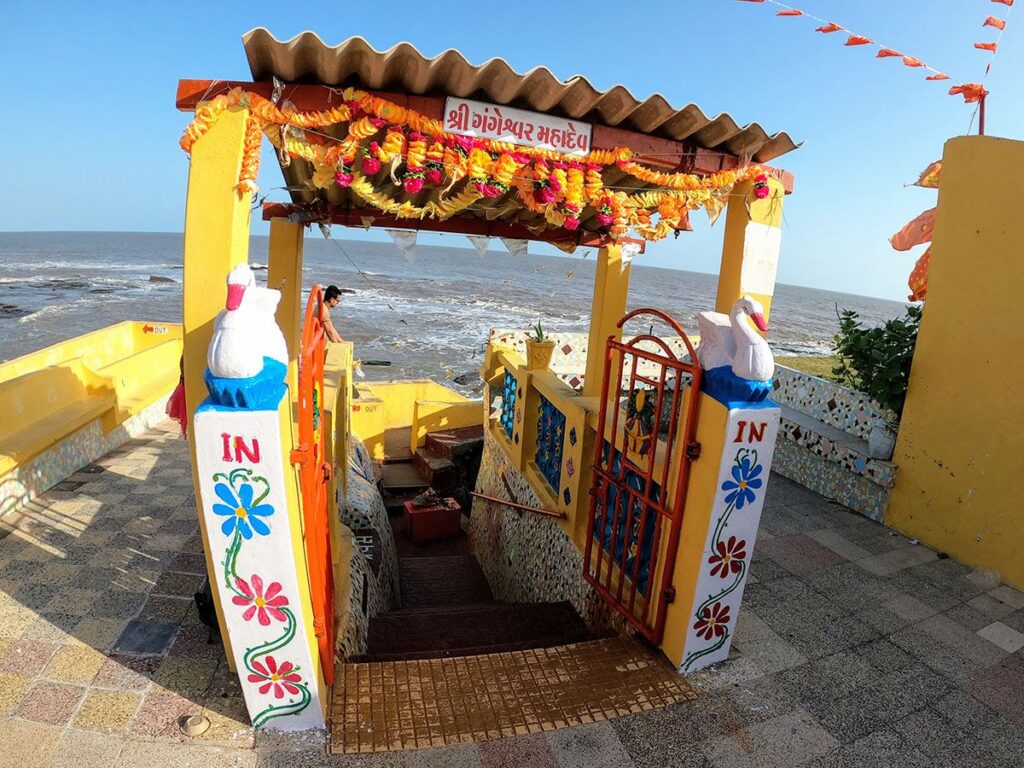
Significance of Gangeshwar Mahadev Temple:
Religious Significance:
- Dedicated to Lord Shiva: As a temple dedicated to Lord Shiva, the Gangeshwar Mahadev Temple is a sacred site for Hindus, particularly Shaivites. Devotees believe that offering prayers here brings blessings and fulfills desires.
- Five Shiva Lingas: The presence of five naturally formed Shiva Lingas adds to the temple’s significance. These rock formations, partially submerged in the Arabian Sea during high tide, are considered manifestations of Lord Shiva himself.
- Mythological Connection: Legend attributes the temple’s creation to the Pandavas during their exile. This association with the epic Mahabharata enhances the temple’s spiritual importance for Hindus.
Historical Significance:
- Ancient Origins: Believed to be over 5000 years old, the Gangeshwar Mahadev Temple is a testament to India’s ancient history and cultural heritage. Archaeological evidence supports this claim, adding to its historical value.
- Architectural Style: Though primarily a cave temple carved into the rocks, the temple showcases influences of various architectural styles. This artistic blend reveals the evolution of architectural practices over time.
- Cultural Significance: The temple serves as a cultural anchor for the local community, attracting pilgrims and tourists throughout the year. Festivals like Maha Shivratri draw large crowds, strengthening the temple’s social and cultural value.
Additional Significance:
- Scenic Beauty: Located on the Arabian Sea coast, the temple offers breathtaking views, adding to its appeal for both religious seekers and nature lovers.
- Unique Experience: The sight of the five Shiva Lingas emerging from the sea during low tide creates a unique and mesmerizing experience for visitors.
Read More>> Thirumanancheri Temple | Kalyanasundareswarar Temple
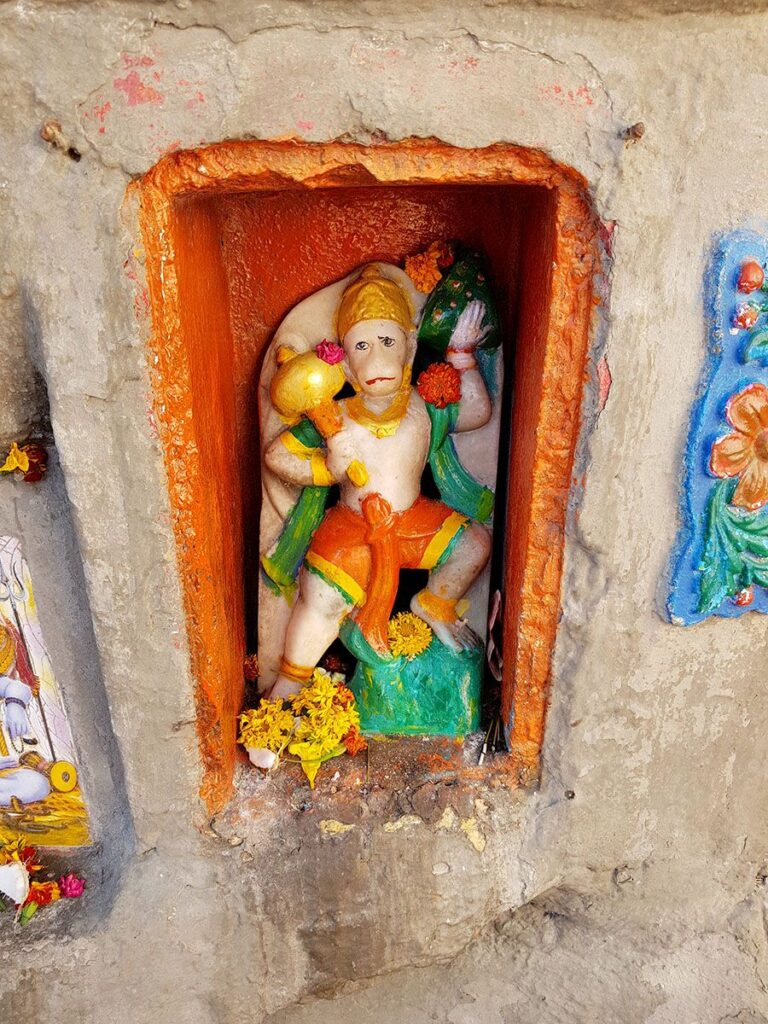
Gangeshwar Mahadev Temple Timing and Rituals:
The Gangeshwar Mahadev Temple in Diu is open from 6:00 AM to 8:00 PM every day. There are no specific rituals associated with visiting the temple, but devotees typically offer prayers, perform darshan (viewing the deity), and light diyas (lamps) or incense sticks.
Here’s a more detailed breakdown of the timings and rituals:
- 6:00 AM: Mangala Aarti (the first arti of the day)
- 7:00 AM: Abhishek (bathing the deity with milk, water, and other offerings)
- 8:00 AM: Shringar (adorning the deity with clothes, jewelry, and flowers)
- 9:00 AM: Bhog (offering of food to the deity)
- 12:00 PM: Sandhya Aarti (the evening arti)
- 6:00 PM: Shayan Aarti (the last arti of the day)
Read More>> Kaleshwaram Temple: Mukthishwara Swamy
Specialty of Gangeshwar Mahadev Temple:
1. Location and Setting: Nestled amidst the scenic beauty of the Arabian Sea, just 3 km from Diu, the temple is a natural cave shrine formed within the rocks. This seaside location creates a mesmerizing ambiance, where the waves rhythmically wash over the sacred lingas, offering a continuous act of worship.
2. Five Shiva Lingas: The temple’s main attraction is the presence of five Shiva lingas, each representing a different form of Lord Shiva. These lingas are carved out of natural rock formations and are of varying sizes. Interestingly, the lingas remain submerged during high tide, only revealing themselves during low tide, adding to the mystical aura of the temple.
3. Mythology and History: Legend has it that the five lingas were installed by the Pandava brothers during their exile. The temple itself is believed to be over 5000 years old, further enhancing its spiritual significance.
4. Unique Darshan Experience: Due to the temple’s location, devotees can touch the Shiva lingas only when the waves recede during low tide. This unique form of darshan, where the ocean itself offers obeisance to the lord, is a truly humbling and unforgettable experience.
5. Tranquility and Serenity: Surrounded by the sound of crashing waves and the cool sea breeze, the temple exudes an atmosphere of peace and tranquility. It’s a perfect escape from the hustle and bustle of everyday life, allowing for deep introspection and spiritual connection.
Read More>> 3 BC Varahaperumal Temple Kumbakonam
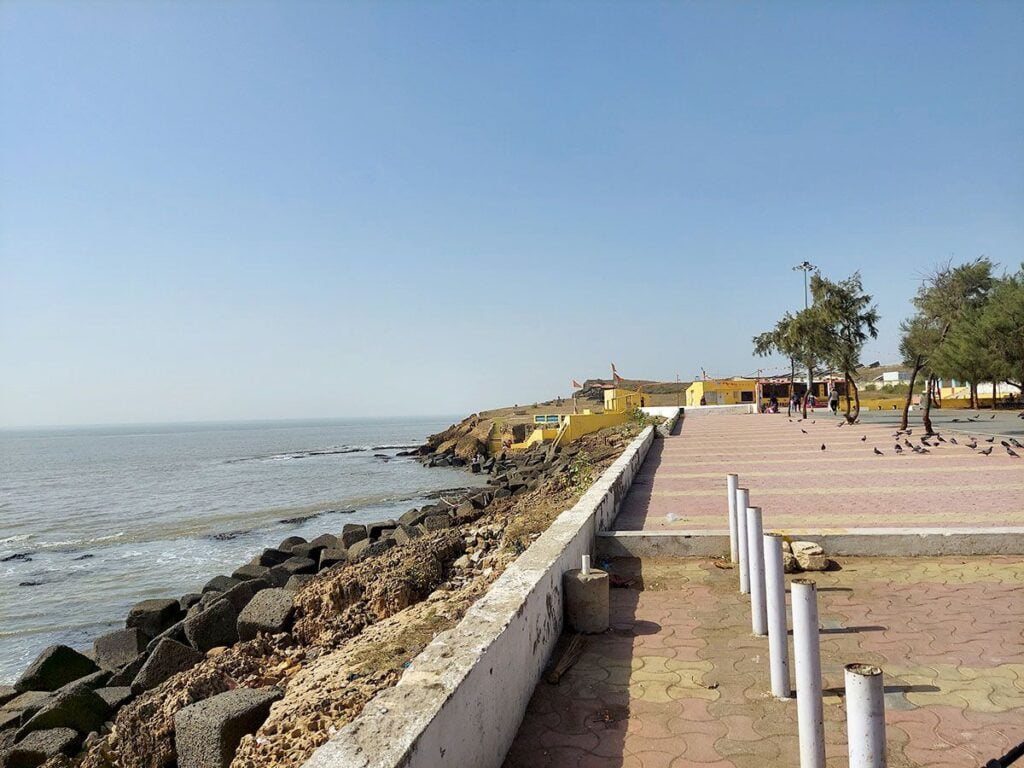
Places to visit near Gangeshwar Mahadev Temple:
- Diu Fort:
- A historic fortress located on the eastern end of the island, Diu Fort offers panoramic views of the sea. It has well-preserved cannons, lighthouses, and a chapel. The fort also houses the Diu Museum.
- Naida Caves:
- Located outside the city wall of Diu Fort, Naida Caves are a network of naturally formed caves and tunnels. The caves are known for their unique rock formations and carvings.
- St. Paul’s Church:
- Constructed in the 17th century, St. Paul’s Church is one of the oldest churches in Diu. It features a Baroque-style architecture and beautiful wood carvings.
- Diu Museum:
- Housed within the Diu Fort, the museum exhibits artifacts that showcase the history and cultural heritage of Diu. It includes wooden carvings, statues, and antique items.
- Gomtimata Beach:
- A serene and less-crowded beach with golden sand, Gomtimata Beach is an ideal spot for relaxation and peaceful walks along the coastline.
- Jallandhar Shrine:
- Dedicated to Goddess Jallandhar, this shrine is located near the beach. It has a large stone structure representing a demon, and it offers scenic views of the Arabian Sea.
- Chakratirth Beach:
- This beach is known for its calm waters and is an excellent place for swimming and water sports. The beach is located near the Diu Fort.
- Shell Museum:
- Diu Shell Museum is a unique attraction displaying a vast collection of seashells. It provides information about different species of shells and marine life.
- Diu Gangeshwar Temple:
- Not to be confused with Gangeshwar Mahadev Temple, Diu Gangeshwar Temple is another Shiva temple located in Diu. It is situated in Fudam village and is known for its peaceful surroundings.
- Chapel of Our Lady of Rosary:
- A historic chapel with a tranquil ambiance, it is one of the oldest churches in Diu and features colonial Portuguese architecture.
Read More>> Ananthagiri Temple Vikarabad: Where Myths and Legends Come to Life
FAQ:
Q: Where is the Gangeshwar Mahadev Temple located?
The Gangeshwar Mahadev Temple is a Hindu temple dedicated to Lord Shiva, located on the seashore of Fudam village in the union territory of Daman and Diu, India. It’s about 3 kilometers away from the main town of Diu.
Q: How old is the temple?
The exact age of the temple is unknown, but some estimates suggest it may be over 5,000 years old. Archaeological work around the site supports this claim. Legend has it that the temple and its five Shiva lingas were created by the Pandava brothers during their exile period in the Mahabharata.
Q: What is the significance of the five Shiva lingas?
The five Shiva lingas carved into the rocks on the seashore are the temple’s most distinctive feature. These lingas are said to represent the five Pandava brothers: Yudhishthira, Bhima, Arjuna, Nakula, and Sahadeva. During high tide, the lingas are partially submerged by the sea, offering a mesmerizing sight.
Q: What is the architectural style of the temple?
The Gangeshwar Mahadev Temple is a cave temple carved into the natural rock formations. Its architectural style is a blend of ancient and modern elements, with some Brutalist influences visible in the concrete structures added later.
Q: What are the timings for visiting the temple?
The temple is open for darshan (viewing the deity) every day from 6:00 AM to 7:00 PM.
Q: Are there any special festivals or events at the temple?
The temple celebrates all major Hindu festivals, including Maha Shivratri, Holi, Diwali, and Janmashtami. During these festivals, the temple is decorated with lights and flowers, and special pujas (prayers) are held.
Q: How can I get to the temple?
The Gangeshwar Mahadev Temple is easily accessible by road from Diu town. You can hire a taxi, take an auto rickshaw, or even walk to the temple if you’re feeling adventurous.
Q: What are some other things to see and do near the temple?
Besides the temple itself, the surrounding area offers several other attractions, including:
- Naida Caves: A group of ancient rock-cut caves located near the temple.
- Gangeshwar Beach: A beautiful sandy beach with stunning views of the Arabian Sea.
- Diu Fort: A 16th-century Portuguese fort offering panoramic views of the island.
How to reach Gangeshwar Mahadev Temple:
By Air:
- Nearest Airport: Diu has its own airport, Diu Airport (DIU), which is well-connected to major cities in India.
- Air Travel: You can book a flight to Diu from major airports like Mumbai, Ahmedabad, or other nearby airports.
- From Diu Airport to Temple: Once you reach Diu Airport, you can hire a taxi or use local transportation to reach Gangeshwar Mahadev Temple. The temple is approximately a 30-minute drive from the airport.
By Road:
- Bus Services: Diu is well-connected by road, and there are regular bus services from nearby cities and towns. You can check with local bus authorities for routes that pass through Diu.
- Private Vehicles: You can also drive to Diu by car. The island is connected to the mainland by bridges, and you can use navigation apps or maps to reach Diu. Once in Diu, you can reach the temple by local transportation or taxi.
By Sea:
- Ferry Services: While Diu is connected to the mainland by road, it is important to note that in the past, there used to be ferry services connecting Diu to Veraval in Gujarat. However, the availability of such services can change, so it’s recommended to check the current status with local authorities.
